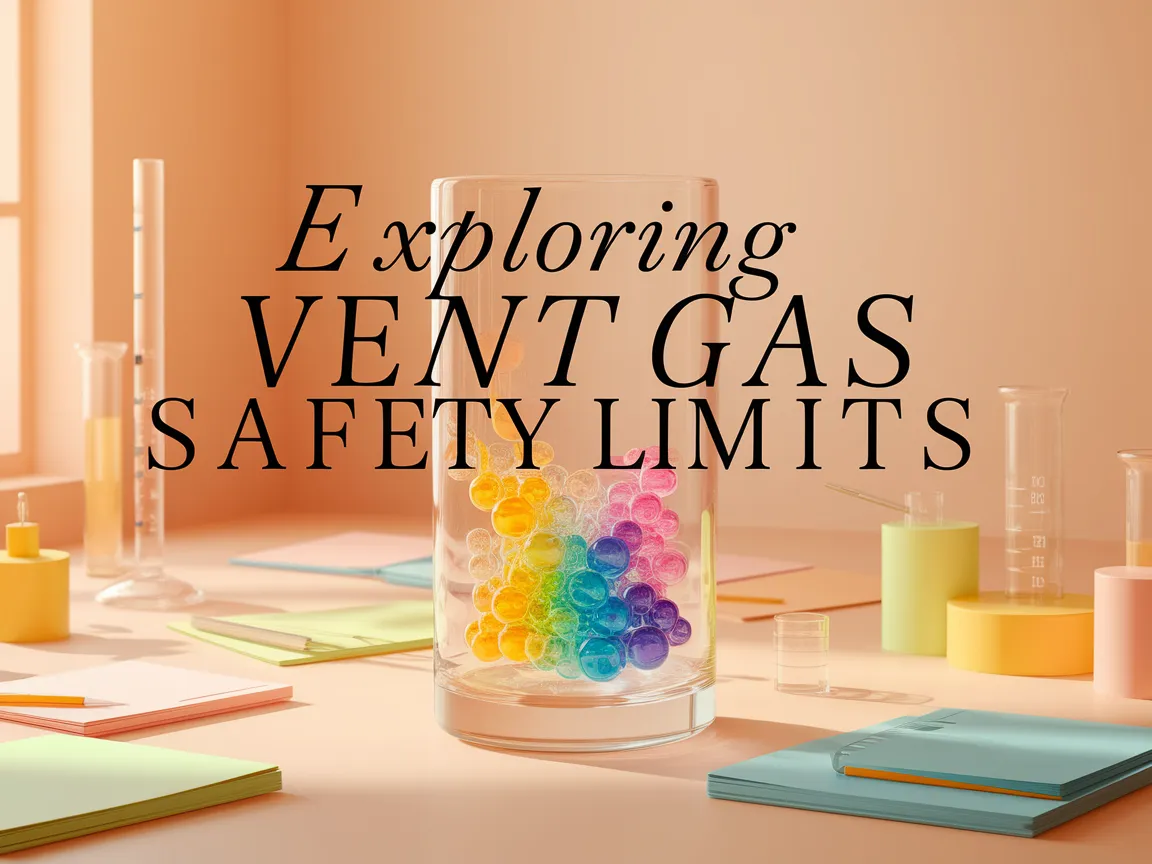Vent Gas Composition: Understanding LFL and HFL in Battery Pack Design
Vent gas composition describes the mixture of gases released from lithium-ion batteries during thermal events like thermal runaway. This gas blend contains flammable components such as hydrogen and carbon monoxide, making LFL (Lower Flammability Limit) and HFL (Higher Flammability Limit) vital safety metrics.
LFL represents the minimum gas concentration in air needed for ignition, while HFL defines the maximum concentration where combustion can occur. Staying outside this flammable range prevents explosions in battery enclosures.
We’ll examine how vent gases form, why LFL/HFL thresholds vary by chemistry, and practical design solutions to manage these risks. You’ll learn measurement techniques and safety strategies for modern battery systems.
What is Vent Gas Composition in Battery Systems?
Contents:
Vent gas composition describes the specific gaseous mixture released during thermal events in lithium-ion batteries. This emission occurs when internal pressure exceeds safety thresholds, activating venting mechanisms. Precise analysis prevents flammable accumulations within battery enclosures.
Defining Vent Gas in Lithium-ion Batteries
Vent gas forms when batteries enter thermal runaway, typically between 80-120°C. Electrolyte solvents like EC and DEC decompose into volatile compounds under heat stress. Gas generation rates can reach 5-10 L/Ah during severe failure scenarios.
Common Components Of Battery Vent Gas
Battery vent gas contains diverse species from electrode and electrolyte breakdown. Flammability varies significantly between components, demanding careful vent gas analysis. Composition fluctuates based on chemistry – NMC cells differ from LFP in gas profiles.
Hydrogen and Its Flammability Concerns
Hydrogen dominates flammability risks with an LFL of 4.0% and HFL of 75.0% in air. Cathode reactions at >150°C produce H₂ rapidly. Its low ignition energy (0.017 mJ) enables easy triggering of combustion chains.
Other Flammable and Non-Flammable Gases
Flammables include carbon monoxide (LFL 12.5%), methane (LFL 5.0%), and ethylene (LFL 2.7%). Non-flammables like CO₂ (15-60%) and O₂ dilute mixtures but affect overall flammable limits. Fluorinated compounds from LiPF₆ decomposition create toxic HF gas.
LFL and HFL: Core Definitions and Relevance to Battery Design
LFL (Lower Flammability Limit) marks the minimum vapor concentration in air where ignition becomes possible. Below this threshold, the mixture is too lean to sustain combustion. Battery vent systems must prevent gas accumulations approaching this critical boundary.
What Does LFL Stand for?
LFL Definition and Flammable Limits Meaning
LFL represents the lowest percentage of gas in air by volume that can ignite when exposed to an ignition source. For battery vent gases, exceeding this concentration creates explosion hazards within confined spaces. Maintaining levels below LFL is non-negotiable for pack safety.
Lower Flammable Limit of Hydrogen
Hydrogen dominates vent gas flammability concerns with an LFL of 4.0% in air. This low threshold makes it exceptionally hazardous. NMC batteries produce 25-50% H₂ during thermal runaway, rapidly approaching dangerous concentrations.
Understanding HFL
HFL Definition and Its Critical Threshold
HFL (Higher Flammability Limit) defines the maximum gas concentration where combustion can occur. Above 75% for hydrogen, mixtures become too rich to ignite. Effective venting prevents both LFL breaches and HFL exceedance during gas accumulation phases.
Factors Influencing LFL and HFL in Battery Vent Gases
Flammability limits fluctuate based on environmental conditions and cell chemistry. These variables directly impact vent system design requirements. An effective coolant flow distribution strategy can mitigate risks associated with these variables. By optimizing the coolant flow, systems can maintain safer operating temperatures and enhance overall efficiency.
Impact Of Temperature on Flammable Limits
LFL and HFL’s Link to Ambient/Operating Temperatures
Higher temperatures widen flammable ranges significantly. At 150°C, hydrogen’s LFL drops to 3.3% while HFL rises to 80%. Battery enclosures experience localized hotspots, creating unpredictable flammability zones during thermal events.
Role Of Gas Composition and Concentration
Gas mixtures alter individual component thresholds. CO₂ diluents raise hydrogen’s LFL to 6%, while methane presence lowers it. Vent gas analysis must account for synergistic effects between 5-7 common gaseous species.
Battery Chemistry-specific Considerations
LFP cells produce 40% less hydrogen than NMC but generate more CO. Silicon anodes increase ethylene output, lowering composite LFL. Each chemistry demands tailored gas venting system designs based on unique emission profiles.
Also See: EV Battery Pack Vent Calculation
Measuring LFL and HFL in Battery Vent Gases
Accurate flammability testing requires controlled methodologies simulating failure scenarios. Data informs critical safety protocols, including battery management system functions for monitoring and protection.
Standard Testing Methods for Flammability Limits
Flammability Threshold Tests
ASTM E681-15 determines LFL/HFL by igniting gas mixtures in sealed chambers. Batteries undergo controlled thermal runaway while sensors record concentrations at ignition points. Tests run from 20°C to 200°C to map temperature dependencies. The processes involved in these tests can relate to the thermal runaway mechanisms observed in lithium batteries, where uncontrolled reactions can lead to dangerous situations. Understanding these mechanisms is crucial for enhancing battery safety and performance.
Differential Thermal Analysis
DTA identifies gas evolution temperatures during heating ramps. Coupled with FTIR spectroscopy, it correlates specific gas releases (H₂, CO) with thermal thresholds like separator melt points (130-160°C). Selecting the right thermal interface material is crucial in optimizing thermal performance. A comprehensive thermal interface material selection guide can help ensure that the materials chosen meet the necessary thermal and mechanical requirements for the application.
Instrumentation for Vent Gas Analysis
Mass spectrometers quantify gas species within 100ms resolution. Catalytic bead sensors monitor real-time LFL percentages, while tunable diode lasers detect hydrogen specifically. Calibration uses NIST-traceable gas mixtures.
Simulated Compliance Testing Protocols
UL 9540A mandates vent gas collection during cell failure in 1m³ chambers. Vent gas composition is analyzed against flammability models to verify designs maintain concentrations below 25% of LFL during worst-case scenarios.
Closing Thoughts
Vent gas composition analysis is critical for safe battery pack design. Monitoring LFL and HFL thresholds prevents hazardous conditions like thermal runaway.
As battery technologies evolve, so must our approaches to gas management. New chemistries may reduce flammability risks, but rigorous testing remains vital.
For more insights on battery safety and design, explore our resources at Battery Pack Design. We cover everything from venting systems to thermal management strategies.
Stay ahead of the curve by understanding these fundamental principles. Proper vent gas handling ensures both performance and safety in modern energy storage systems. When batteries overheat, managing gas release through thermal runaway gas venting pathways is crucial. Effective venting pathways can help prevent hazardous situations by directing gases safely away from sensitive areas.
Additional Resources for You:
- ISO/TC 22/SC 37 – Standards for Electrically Propelled Vehicles
- Lower flammability limit – Wikipedia
- Lower Flammability Limit
- How to Measure Flare Vent Gas Composition and Net Heating Value | University of Utah Partnerships | J. Willard Marriott Digital Library
- Gases – Explosion and Flammability Concentration Limits



